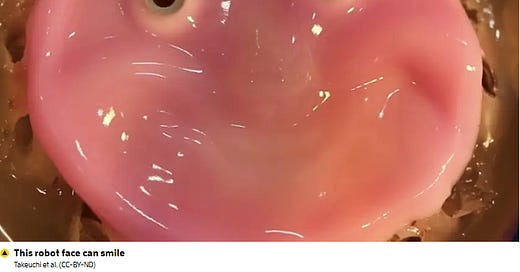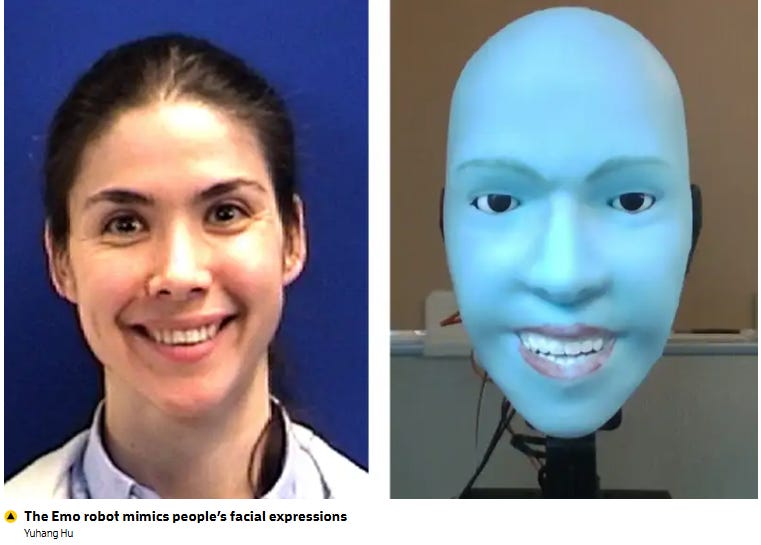Smiling robot face is made from living human skin cells
New Scientist posted a freaky video on Twitter showing an experimental face intended for a robot made from living human skin cells capable of smiling. Why are they putting living skin on robots?
The New Scientist has posted a freaky video showing an experimental face intended for a robot that is made from living human skin cells, and is capable of smiling.
“A technique for attaching a skin made from living human cells to a robotic framework could give robots the ability to emote and communicate in a more life-like way,” the article accompanying the New Scientist’s tweet stated.
Nothing To See Here, Just A Smiling Robot Face Made from Living Human Flesh
July 1, 2024
A smiling face made from living human skin could one day be attached to a humanoid robot, allowing machines to emote and communicate in a more life-like way, say researchers. Its wrinkles could also prove useful for the cosmetics industry.
The living tissue is a cultured mix of human skin cells grown in a collagen scaffold and placed on top of a 3D-printed resin base.
Unlike previous similar experiments, the skin also contains the equivalent of the ligaments that, in humans and other animals, are buried in the layer of tissue beneath the skin, holding it in place and giving it incredible strength and flexibility.
Michio Kawai at Harvard University and his colleagues call these ligament equivalents “perforation-type anchors” because they were created by perforating the robot’s resin base and allowing tiny v-shaped cavities to fill with living tissue.
This, in turn, helps the robot skin stay in place.
The team put the skin on a smiling robotic face, a few centimetres wide, which is moved by rods connected to the base. It was also attached to a similarly sized 3D shape in the form of a human head (see below), but this couldn’t move.
The outlet writes “a smiling face made from living human skin could one day be attached to a humanoid robot, allowing machines to emote and communicate in a more life-like way, say researchers.”
Commenting on the News Scientist’s video and article Modernity News noted the following.
What researchers are saying this now? Was Dr Evil not available for comment?
Imagine that pink nightmare smiling down at you as it announces it’s your new master.
The article continues, “The living tissue is a cultured mix of human skin cells grown in a collagen scaffold and placed on top of a 3D-printed resin base.”
Of course it is. Wouldn’t expect anything less for Robot McSkin Face.
It continues, “Unlike previous similar experiments, the skin also contains the equivalent of the ligaments that, in humans and other animals, are buried in the layer of tissue beneath the skin, holding it in place and giving it incredible strength and flexibility.”
So, you’ll struggle to rip it off as you desperately attempt to reveal to the world the true identity of the new overlord.
But seriously, why does it need to be made of living human skin? Can’t we just have the future killer robots look like robots, please?
Are they intent on recreating The Terminator movies exactly? Dystopian films and books are supposed to be warnings, not blueprints.
Read more: This robot predicts when you're going to smile – and smiles back
This robot predicts when you're going to smile – and smiles back
An AI-powered robot named Emo watches people’s facial expressions and tries to match them, in an effort to make robots more relatable
By Alex Wilkins
A humanoid robot can predict whether someone will smile a second before they do, and match the smile on its own face. The creators hope the technology could make interactions with robots more lifelike.
Although artificial intelligence can now mimic human language to an impressive degree, interactions with physical robots often fall into the “uncanny valley”, in part because robots can’t replicate the complex non-verbal cues and mannerisms that are vital for communication.
Now, Hod Lipson at Columbia University in New York and his colleagues have created a robot called Emo that uses AI models and high-resolution cameras to predict people’s facial expressions and try to replicate them. It can anticipate whether someone will smile about 0.9 seconds before they do, and smile itself in sync. “I’m a jaded roboticist, but I smile back at this robot,” says Lipson.
Emo consists of a face with cameras in its eyeballs and flexible plastic skin that has 23 separate motors attached to it by magnets.
The robot uses two neural networks: one to look at human faces and predict their expressions and another to work out how to produce expressions on its own face.
READ MORE:
Neuroweapons and the Worldwide “Battle” to Control of Human Brains. Must be Stopped Immediately
WEF Scientists Unveil Supercomputers Powered by Lab-Grown Human Brains
Share or comment on this article.
Your support is crucial in exposing fake news and in helping us defeat mass censorship.









